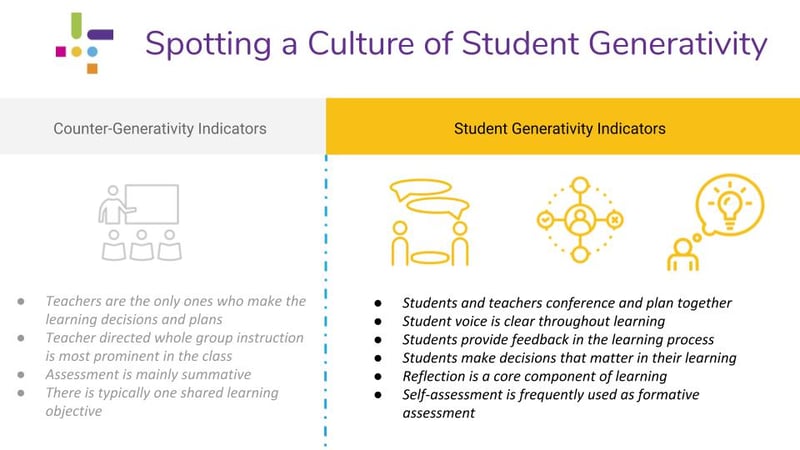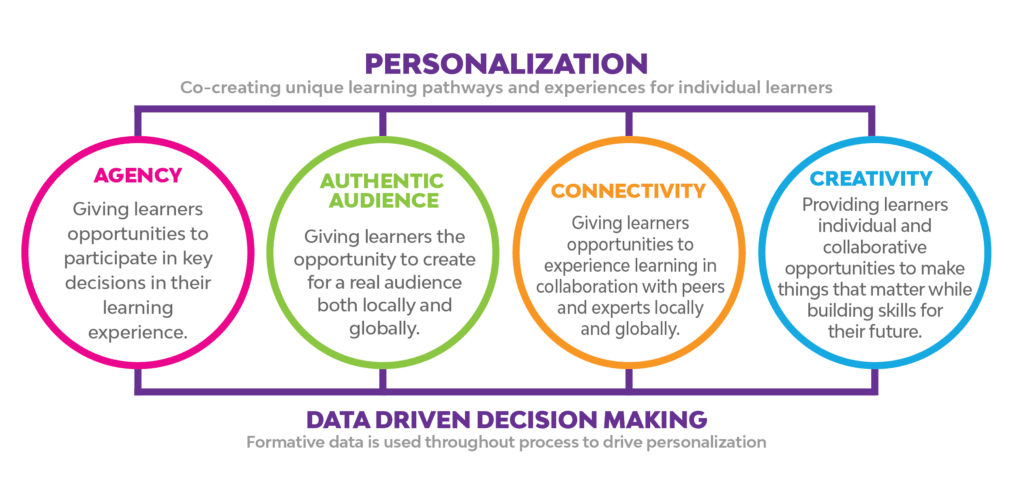Generativity in Action - 3 Steps to Building a Culture of Student Generativity
As a principal, I hosted many students who were asked by their teachers to “take a break” from their classrooms due to misbehavior. When this happened, I started with student reflection, having them write what happened from their perspective. This exercise raised metacognitive awareness of the situation from different perspectives, and by providing an opportunity for students to tell me their accounts allowed them to feel heard, often lowering their frustration or anger, enabling a more constructive reflection conversation. Subsequently, I would have students do the same exercise but from the first-person perspective of the teacher. Among the most fascinating and productive of these experiences went something like this:
Tom (from his student perspective): I was talking with Luca about our business. We have a retail business buying and reselling hoodies and we’re trying to plan inventory. We’ve been arguing about it and Mr. Smith (math teacher) got mad at us because we were talking in class. I tried to tell him it was about math but he got mad at me and told me I was being disrespectful and to leave the class to come here.
Tom (from Mr. Smith’s perspective): I was teaching a lesson and Tom was talking with Luca. I told them to stop talking and he was rude, saying “What? It’s about math!” So I told him to go see you.
As we explored this situation more deeply, the process led to an opening in a strained relationship between Tom and Mr. Smith. They jointly created an opportunity for more personalized and relevant learning for Tom. In a short time, the whole class was engaged in building unique business plans to apply mathematical concepts through project based learning and they won the Stock Market Game by the end of the year.

Mr. Smith had not done anything “wrong” as a teacher in upholding a behavioral expectation he set. However, the one-size-fits-all learning approach was causing a breakdown in his class. A student clearly invested in mathematical thinking and in need of skills was checking out of math. This is an all too common occurrence in classrooms today. Students are immensely curious, but they are taking their curiosity elsewhere. To keep engagement and relevance high, we must strive to increase generativity in the classroom and position it as a core learning outcome.
In Part 1 of our Generativity series, LINC Co-Founder Jason Green shared the foundational components of Dr. Arnetha Ball’s Model of Generative Change and how its “reflect, tinker, grow” cycle fosters innovative learning transformation. In Part 2 of the series, I shared three strategies for transforming a traditional faculty mindset to one of generativity and present several “in-action” examples to support the work. To build upon this generativity foundation and close out the series, I am sharing three strategies for transforming traditional classrooms into generativity hubs.
Step #1: Focus on the PAACC
In Blended Learning in Action, we share how digital tools can create opportunities for learning innovation. However, tools alone do not make learning innovative. Just as the SAMR framework points out, when we use technology only to substitute for non-digital tools, we simply do the same things in new ways. Even when we redefine learning through technology, and learning looks very different than it traditionally has, we may still not reach transformation that will build generativity in our students. Rather than focusing on a specific tool, technology level, or blended learning model, we encourage teachers to focus on the PAACC framework. By using the PAACC as a compass, teachers can better ensure that they are increasing personalization, agency, authenticity, connectivity, and creativity.

| In Action: I am a teacher who has increased engagement through the use of technology. However, I want to take my practice to a new level so that I can personalize learning in my class and help my students build skills for their future. I share the PAACC framework with my students and lead a discussion about the value of shifting to increase PAACC practices in our class. I then share a unit of study I did last year with my current class and invite them to discuss how we can increase each component of the PAACC within the unit. I create a Padlet board and have students add ideas that work to increase each area of the PAACC in the unit. |
Step #2: Model Generativity & Solicit Feedback
When teachers begin trying new tools or models in class, they often initially don’t work. Too often, teachers revert to old practices rather than persist out of fear of being criticized by their peers and their students for unpolished practices. This happens when we stick to the old paradigm of teachers as sage on the stage. If we don’t take the time to engage students as part of our professional learning journey, they will continue to operate from that paradigm with the expectation that we have all the answers. If we make students part of the planning process by co-designing lessons and providing feedback, it not only lowers the risk to open the door for tinkering together, but also models generativity in action, sending the message that learning in the classroom is everybody’s job.
| In Action: I am a member of the transformation team who wants to share my emerging Station Rotation practice with digital tools I’m trying out in my class. My principal has used a “Pineapple Chart” to have our team share what we are trying in our classes, so I’ve added my Station Rotation to the chart with the days my colleagues observe. I put an “Innovator in Action” sign up on my door during these times as a reminder that we are innovating, not showcasing. I engage my students in the experience of tinkering and let them know I would like their feedback, even during the lesson. After a week of the new practice, I survey students and share their feedback at the next PLC meeting where my group is exploring blended learning models. |
Step #3: Assessment as Learning
The traditional sequence of learning starts with knowledge transfer and concludes with an assessment. In this sequence, assessment is not really part of the learning but rather a separate process to measure its effectiveness. In a generative classroom, assessment becomes part of the learning process throughout the sequence. Instead of measuring learning, assessment drives learning. This type of formative assessment can take many forms such as surveys, live quizzes, polls, comments and suggestions in documents, discussion contributions, self-reflection using rubrics, and conferences. Student reflection should be a core assessment practice in a generative classroom. To build generativity, students have to continuously engage in the cycle of reflection about the problem they are trying to solve, what they already know, what they still need to know, and what resources they can access to bridge this gap.
| In Action: I am a student preparing for a student-teacher writing conference in my history class. I have drafted the first two paragraphs of a news article for my writing assignment. Using the single-point rubric our class collaborated on, I identify how my article meets each indicator. I put an example to discuss in each area of the rubric. Since my teacher and I have identified textual support as an area of growth for me in my writing, I go through my article and highlight the research evidence I have included. During the conference with my teacher, he makes comments on the shared document to provide feedback. We discuss my rubric assessment and I use both the comments and the conference feedback to continue working on my article. |
It can be daunting to shift towards a student-centered learning environment where students are stakeholders who have agency and voice in their learning. It requires teachers to let go of “having control” of the learning in their classes and to trust students more than we typically do in a traditional model. However, as students are empowered as agents, they gain a more authentic connection to their learning and subsequently become more engaged. Most importantly though, they build their capacity as problem-solvers who can tackle new challenges as they emerge, a critical skill to navigate rapid change in their uncertain futures.